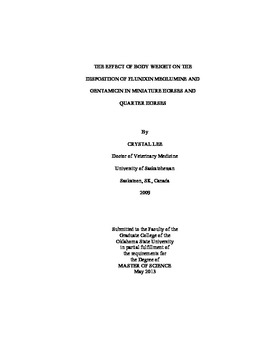| dc.contributor.advisor | Maxwell, Lara K. | |
| dc.contributor.author | Lee, Crystal Dawn | |
| dc.date.accessioned | 2014-09-24T14:18:08Z | |
| dc.date.available | 2014-09-24T14:18:08Z | |
| dc.date.issued | 2013-05-01 | |
| dc.identifier.uri | https://hdl.handle.net/11244/11104 | |
| dc.description.abstract | In most species, large variations in body size necessitate dose adjustments based on an allometric function of body weight. Despite the substantial disparity in body size between Miniature Horses and light-breed horses, there are no studies investigating appropriate dosing of any veterinary drug in Miniature Horses. The purpose of this study was primarily to develop a basis for pharmacologic scaling in the horse, and to determine the scaling exponents with which flunixin meglumine and gentamicin relate to body weight in the horse. A secondary purpose was to evaluate the current status of the therapeutic monitoring of gentamicin in the United States and Canada. To investigate pharmacologic scaling, a standard dose of flunixin meglumine was administered intravenously to eight Miniature Horses and eight Quarter Horses, and three-compartmental analysis was used to compare pharmacokinetic parameters between breed groups. The total body clearance of flunixin was 0.97�0.30 mL/min/kg in Miniature Horses and 1.04�0.27 mL/min/kg in Quarter Horses. Similarly, a standard dose of gentamicin was administered intravenously to eight Miniature Horses and eight Quarter Horses, and three-compartmental analysis was used to compare pharmacokinetic parameters between breeds. The total body clearance of gentamicin components C1a, C2, C1, and summed components was 0.68�0.15 mL/min/kg, 0.69�0.16 mL/min/kg, 0.72�0.17 mL/min/kg, and 0.71�0.16 mL/min/kg respectively in Miniature Horses and 0.59�0.10 mL/min/kg, 0.61�0.09 mL/min/kg, 0.62�0.10 mL/min/kg, and 0.62�0.09 mL/min/kg respectively in Quarter Horses. There were no significant differences between Miniature Horses and Quarter Horses in clinically significant pharmacokinetic parameters (P>0.05) for either flunixin meglumine or gentamicin. An email-based survey disseminated to each of the veterinary teaching hospitals in the United States and Canada revealed that 42% of respondents currently perform therapeutic drug monitoring of aminoglycosides, with an average of 3.9 samples annually. The majority of veterinary TDM is performed in equine medicine. The fact that TDM is performed infrequently in veterinary teaching hospitals is at odds with the importance of TDM for aminoglycosides as demonstrated in human medicine. In conclusion, both flunixin meglumine and gentamicin may be administered to Miniature Horses at the same dose rates used typically in light-breed horses, with similar recommendations for TDM of gentamicin. | |
| dc.format | application/pdf | |
| dc.language | en_US | |
| dc.publisher | Oklahoma State University | |
| dc.rights | Copyright is held by the author who has granted the Oklahoma State University Library the non-exclusive right to share this material in its institutional repository. Contact Digital Library Services at lib-dls@okstate.edu or 405-744-9161 for the permission policy on the use, reproduction or distribution of this material. | |
| dc.title | Effect of Body Weight on the Disposition of Flunixin Meglumine and Gentamicin in Miniature Horses and Quarter Horses | |
| dc.type | text | |
| dc.contributor.committeeMember | McFarlane, Dianne | |
| dc.contributor.committeeMember | Holbrook, Todd | |
| osu.filename | Lee_okstate_0664M_12735.pdf | |
| osu.accesstype | Open Access | |
| dc.description.department | Veterinary Biomedical Sciences | |
| dc.type.genre | Thesis | |
